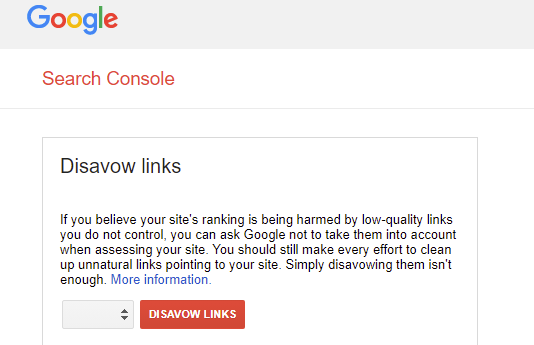Have you ever used Google's disavow tool? If you have been actively involved in Search Engine Optimization (SEO) for your website over the last few years then there is a very good chance that you have unnatural links pointing to your web site. These unnatural links can hurt you in the eyes of Google's Penguin algorithm or in some cases, they can even get you a manual unnatural links penalty so in this article, we will talk about some very practical things that will definitely help you when using the Google's disavow tool. These free tips should surely help you whether you are an experienced SEO or a small or medium sized business owner who is trying to clean up your bad backlinks in your website.
What is Google Disavow tool?
Introduced in the year 2012 in October, the Google disavow tool is Google's way of allowing you to ask Google not to count some particular links that point to your website.
Using the Google disavow tool incorrectly can hurt you more than you can imagine. You should only be disavowing links that you know were made with the whole intention of manipulating Google's search engine results. Many articles and blogs have been written to help the website owners decide which links are unnatural but there are not many articles written that take you through the process of auditing as well as disavowing your links from the start to the end.
Our sincere hope is that this article on how to correctly use Backlink Removal Tool will help answer all the questions you have about using Google Disavow tool. If there is something that we do not cover, then feel free to call us anytime as we would be glad to help you out.
Step 1: Conduct a Link Audit
This just got a whole lot easier as Mr. John Mueller from Google has said that you don’t need to use third-party tools and that Google Webmaster Tool in itself is fine. If you don’t believe it then just know that Marie Haynes has also said that she uses WMT links exclusively to get manual penalties removed and it works for her totally.
To use the Backlink Removal Tool, you’ll find the links you need by going to Google Webmaster Tools and then Select your web site and follow the below steps-
Select Traffic > Links to Your Site > More > Select “Download Latest Links” > Export to .CSV or Google Documents. And yes, the first step is done within few clicks.
Step 2: Analyze the Link Data
Google search console is a tool that helps you monitor and trouble shoot your website's name in the SERP. In this step, you will find thorough instructions on how the analyzing of the data is done by clicking on “How to Conduct a Link Audit“. The most imperative consideration is that it is fine to use one of the ever expanding numbers of link evaluation tools, however, a thorough manual review will be compulsory to “audit” the tool’s output.
Step 3: Documentation
We are a big fan of creating a Google Drive account dedicated to the link cleanup campaign and we record all of the details of your outreach campaign on a spreadsheet. Include the Google Drive credentials in your reconsideration request as this gives Google the choice of being able to look at all of the work on your spreadsheets and confirm how much effort went into the emailing thing.
Step 4: Link Removal Through Email Outreach
The most effective emails are personalized and do not really require any thought on the part of the recipient. So let the webmaster know where the link is positioned on the page as well as the anchor text and where exactly it points. By including these particular details, you will be perceived as human and you will make it easy for the webmaster to find and remove the unnatural link.
Step 5: Time to Use the Disavow Tool
Firstly, Log into Google Webmaster Tools, then click on the Disavow Tool and select your particular domain. Clicking Disavow Links would prompt a menu asking you for a file containing the links you want to disavow from your website. Next thing you need to do is upload the file and then you are done.
Step 6: Reconsideration Request (This is Optional)
In case you’re under a manual penalty, will you need to file a reconsideration request and when filing your request, here are some key points that you should consider:
- Be Specific and To The Point.
- Confess everything and Hide Nothing
- Accept Responsibility that is Explain why it will NEVER happen again in future.
Conclusion
Disavowing links can be very intimidating if you don’t know what exactly to do and sometimes, you can damage your SEO if you abuse disavowing, so it is crucial to get it right. Through Google Search Console and Google Disavow Tool, your overall SEO will also improve and so you will probably see more traffic coming to your website and even more high-quality backlinks that actually help you out in long term. Hopefully, you have a better understanding of why and how you should disavow the backlinks and when you should do it because we know it is scary at first, but once you get used to it, it would seem super simple.

















Post Comments